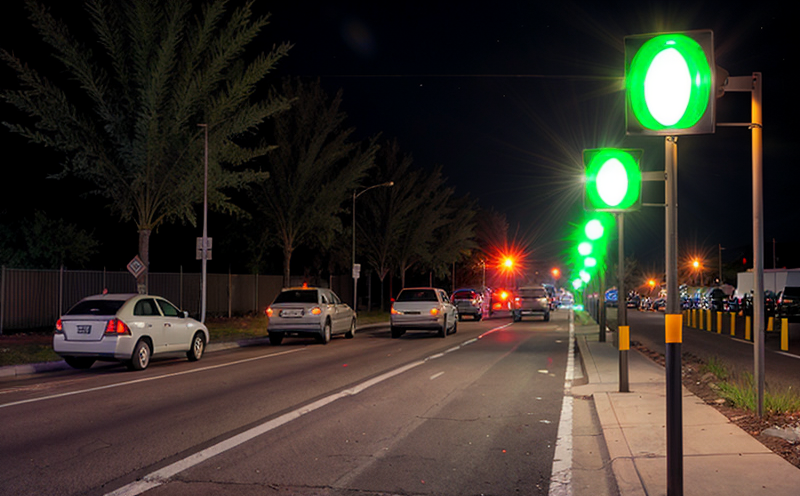EN 50102 Mechanical Impact Testing of Traffic Signal Fixtures
The EN 50102 standard is crucial in ensuring that traffic signal fixtures are designed and manufactured to withstand the harsh environmental conditions they encounter. This test evaluates the mechanical impact resistance of traffic signal lights, which is vital for safety and reliability.
During this test, specimens are subjected to controlled impacts using a calibrated pendulum or drop hammer. The purpose is to simulate real-world scenarios where fixtures might be exposed to sudden impacts from vehicles or other external factors. This ensures that the fixtures maintain their functionality and integrity under stress conditions.
The standard specifies the minimum impact energy required for these tests, which are conducted at different locations on the fixture to cover various potential points of impact. Compliance with this test is essential for manufacturers aiming to meet regulatory requirements and ensure product safety.
For quality managers and compliance officers, understanding EN 50102 helps in ensuring that products meet all necessary standards before being deployed. R&D engineers can use the insights gained from these tests to improve designs and materials used in traffic signal fixtures. Procurement teams benefit by having a clear understanding of what they should look for when specifying or selecting components.
The mechanical impact test is one part of a broader suite of tests that ensure the reliability and safety of traffic signaling systems. It contributes significantly to the overall performance and longevity of these critical infrastructure elements.
Scope and Methodology
| Parameter | Description |
|---|---|
| Test Specimen | The specimen to be tested is a traffic signal fixture representative of the product range. |
| Pendulum Energy | Calibrated to deliver specific impact energies as per EN 50102 requirements. |
| Test Locations | Impacts are conducted at multiple points on the fixture, including corners and edges. |
| Data Collection | Impact force and displacement are measured using high-precision sensors. |
The test setup involves placing the traffic signal fixture between two supports. The pendulum or drop hammer is then raised to a specified height, ensuring it delivers the required impact energy when released. The impact forces and displacements are continuously monitored during testing.
Data collected from these tests provides valuable insights into how well the fixtures can withstand impacts that they might experience in real-world conditions. This information is crucial for improving product design and ensuring compliance with international standards.
Customer Impact and Satisfaction
The success of EN 50102 mechanical impact testing lies not only in the technical specifications but also in its practical application that enhances customer satisfaction. By adhering to this standard, manufacturers ensure that their products are robust enough to handle unexpected impacts without failing.
For end-users such as municipalities or transportation authorities, compliance with EN 50102 translates into safer and more reliable traffic signaling systems. This reduces the risk of failures during critical moments when signals need to function correctly.
R&D teams benefit by having a clear roadmap for product development that aligns with international standards. They can focus on innovation within defined parameters, ensuring that any new designs or materials are compatible with existing infrastructure and regulatory requirements.
Quality managers gain peace of mind knowing they are meeting stringent global standards that enhance the overall performance and longevity of traffic signal fixtures. This leads to higher customer satisfaction levels as products perform consistently across various environments.
Competitive Advantage and Market Impact
- Ensures compliance with international standards, enhancing credibility.
- Reduces the risk of product failures in critical situations.
- Improves brand reputation among customers who prioritize safety and reliability.
- Paves the way for easier market entry into regions that require adherence to EN 50102.
The ability to demonstrate compliance with EN 50102 can give manufacturers a competitive edge, particularly in markets where regulatory compliance is stringent. By meeting these standards, companies can differentiate themselves from competitors and attract customers who prioritize safety and reliability.
Manufacturers that invest in robust testing processes aligned with EN 50102 are better positioned to capture market share and maintain long-term relationships with clients. This strategic approach not only enhances their competitive position but also contributes positively to the overall quality of traffic signaling systems worldwide.





